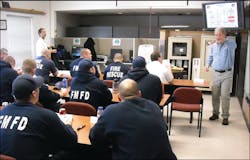In the world of hazardous materials response and especially involving hazmat chemistry, there is a revolution occurring. It is not just a quiet revolution; in fact, it is an up-roar. Responders across the country are singing the praises of a new way to look at hazmat chemistry that is called the "HazMat IQ" system. The reason is simple; responders can see immediate application of the material to their response world. Essentially, the HazMat IQ system has broken highly complex chemistry down to only what is needed to safely function in the field.
The brainchild of two experienced fire and hazmat responders, Cris Aguirre and Joe Gorman (see Photo 1), the HazMat IQ system has been time-tested and proven to be effective on emergency hazardous materials response. The learning concept is built around empowering a responder to understand how chemistry information can be used to think through tactical decision making. It is similar to what Lao Tzu, an ancient Chinese sage, once stated; "Give a man a fish and you feed him for a day. Teach a man to fish and you feed him for a lifetime." This distinction is vitally important; the former is reliant on others, the latter is self-reliant. In essence the system does not teach what to think but how to think and then, how to act on one's own. By the end of just one class session responders are taught how to use the system and how to think utilizing the Smart Charts that are provided to each learner.
The one-day training session covers chemistry in a basic way along with how to use the Smart Charts, 3 laminated charts with "how-to" information on both sides. In a mere morning class period students usually understand how the system works including how to select personal protective equipment (PPE) and air monitoring instruments (meters). The system begins with being alerted by your dispatch, just like being toned out in a fire station for a fire call. Quite often, responders get clues of what has been released through on-location sources or callers. Based on a chemical name or ID number they can then make decisions within this system.
By the chemical name alone responders can decide if the material is an "Above-the-Line" chemical or a "Below-the-Line" chemical. This simple categorization helps determine the basic and definitive hazards of the material. In a total time of less than 10 to 20 seconds responders can make this distinction and then begin to follow a standard operating guideline (SOG) based on the chemical and physical hazards of the material. In this first step, all of this is done with the basic chemistry principles intertwined in the system. The SOG also includes the appropriate PPE and meters to use for entry.
After the first step determination is made responders then move to verifying the information in Step 2. Over approximately two minutes and through research sources, responders can tweak their initial determination or size-up. This step is important to make sure the size-up is accurate. With Step 2 responders also verify the personal protective equipment (PPE) and meters to use for their response through the use of the Smart Charts. And, most of Step 2 is completed while responders are enroute.
Once arriving on location responders should be well prepared to go to work. In Step 3 responders gather the identified PPE and meters and get ready for their entry. The last step, number 4, responders make entry to either affect a rescue or for reconnaissance. Information gathered from the initial entry can help decide response actions needed to resolve the release. All of this material, and all six "Smart Chart" pages, are covered completely in the morning classroom session. The afternoon session covers a few more pertinent response considerations but responders also get to practice the system on their own through response scenarios (see Photo 2).
To better understand the HazMat IQ system the following is presented; in an industrial setting several steel 55-gallon drums fell off a pallet that was being handled by a forklift. One drum is damaged, on its side, and leaking from its chime near the top. The forklift operator shut off the forklift and vacated the area. He reports that he was moving drums labeled "acrylonitrile".
Hazmat personnel arrive after being called and gather additional information. They also set-up initial site control and then consult their Smart Charts to begin the four-step process. First step! Is "acrylonitrile" a chemical name that is "Above or Below the Line?" Based on the initial training the determination is that it is an "Above-the-Line" chemical!
Above the Line chemicals have flammable tendencies and the SOG from the Red Box will need to be followed initially. The Step 1 size-up provides a worst case scenario that is the starting point for the system, and Red Box materials will usually be liquids or gases. They are usually flammable so they have flashpoints and flammable ranges. Red Box materials also have ionization potentials, they turn pH paper red, and they require turnout gear for personal protection for initial entry. Leak sealing and spill handling will most likely require Level B clothing, or even Level A with proper precautions. Red Box chemicals will require 300 feet isolation zones for gas releases and 150 feet for liquid spills.
Above the Line materials are also better outlined on Smart Chart #3. The prefix "acryl" is found in the flammable clues box on this chart which verifies the material is flammable. In the "name clues" box the suffix ends in "nitrile" and these types of materials are flammable, toxic, corrosive, and polymerization hazards. The meters that should be used for these materials include a temperature gun, combustible gas indicators (CGIs), photoionization detectors (PIDs), flame ionization detectors (FIDs), and colorimetric tubes or chips. The classroom session also stresses the importance of entering with radiation meters along with F paper (for fluorine detection) and pH paper. These indicator papers are attached as "heads-up" displays on the outside of the responders facepieces.
To further expand your size-up, Smart Chart #3 lists turnouts for initial atmospheres up to 10 percent of the lower explosive limit (LEL), Level B for situations below one percent LEL, and even Level A if needed for corrosive atmospheres.
So, the 4 step system has provided a size-up and a course of action for this scenario. The first question was answered with acrylonitrile being an Above-the-Line material with Red Box or flammable hazards. Verification with Step 2 found the hazards to be accurate along with what PPE and meters to use for acrylonitrile responses. The Smart Charts list acrylonitrile as a "Red 9" SOG and the needed equipment to ready for Step 3 upon arrival. Step 4 would enable responders to enter the spill area safely and correctly dressed to better characterize the environment with meters and assess the needs for complete mitigation.
That's it! The HazMat IQ system that has been outlined here is quite often looked upon as being revolutionarily simple! The basic chemistry is implicit in the system and the heavy lifting has been done for all responders. By only looking at the "need-to-know" chemistry information and along with the utilization of the Smart Charts, responders can select their PPE and meters to handle hazmat releases. This system can also handle unknown materials with the utmost safety.
After attending this one day session, hazmat chemistry is often looked upon in a completely different light. In fact, experienced hazmat responders have stated that they learned more in a one-day HazMat IQ class session than they learned in their entire career. That is, after all, the definition of "revolution": a sudden, radical, or complete change, and a fundamental change in the way of thinking about or visualizing something. And, because of the HazMat IQ revolution, hazmat response and hazmat chemistry will never be looked upon the same again.
Learn More About HazMatIQ Live! Co-Founders Cris Aguirre and Joe Gorman will present "HazMatIQ - First Responder Operations" on July 23 at Firehouse Expo in Baltimore.
DAVID PETERSON, a Firehouse.com Contributing Editor, is a 30-year veteran firefighter and hazmat team responder. He writes and presents on a variety of fire service issues for numerous websites, trade magazines, and conferences. David is member of the Wisconsin FLAME group, LLC. He has a B.S. in fire service management from Southern Illinois University, is a graduate student in leadership at Grand Canyon University, and is a graduate of the National Fire Academy's Executive Fire Officer Program. You can reach David by e-mail at [email protected].
About the Author

David F. Peterson
David F. Peterson, MS, EFO, is a 35-year veteran of the fire service and a retired Wisconsin fire chief. He is currently a fire training coordinator for Blackhawk Technical College in Janesville, WI. Peterson has served as a company officer, training officer, hazmat team leader, chief officer and incident commander. He is a past board member for the Wisconsin State Fire Chiefs Association, a national presenter on fire service and hazmat topics, and he founded the Wisconsin Association of Hazardous Materials Responders in 1992. Peterson has a master’s degree in executive fire leadership and disaster preparedness from Grand Canyon University and a bachelor’s degree in fire service management from the University of Southern Illinois. He is also a graduate of the National Fire Academy’s Executive Fire Officer Program. He is a principal partner of White Helmet Innovations, LLC.
